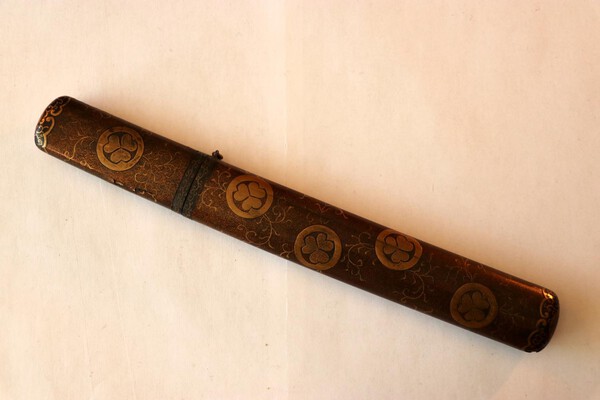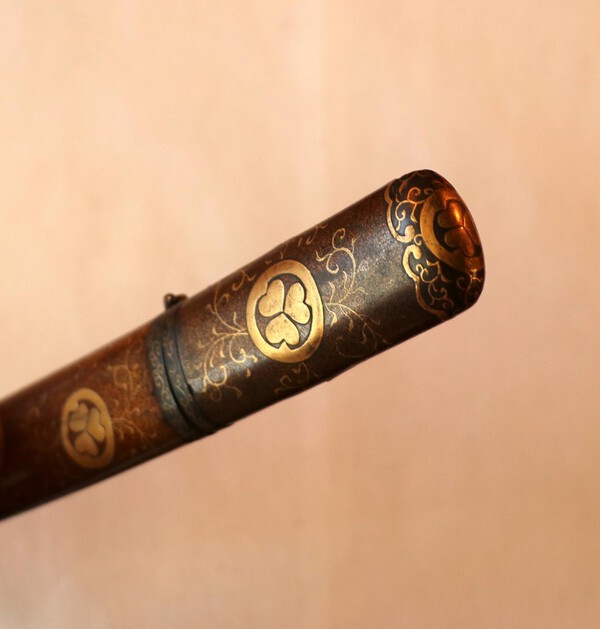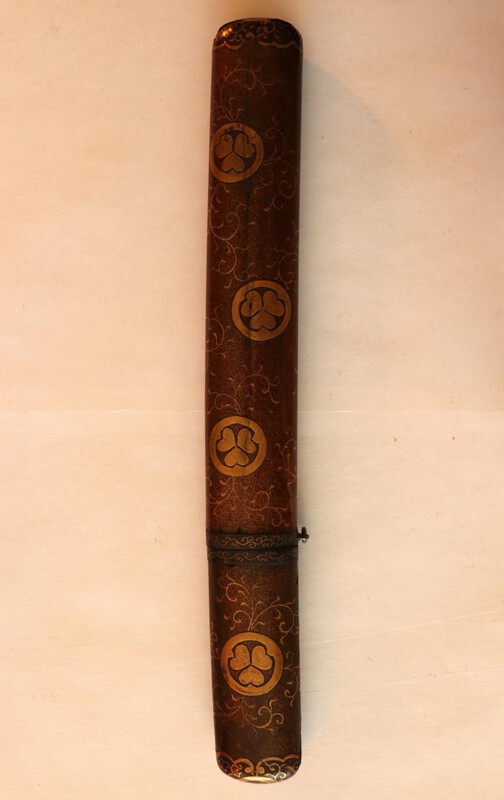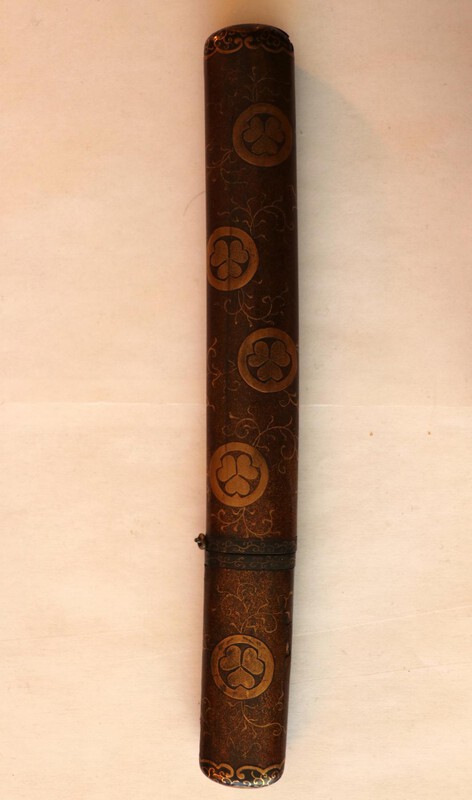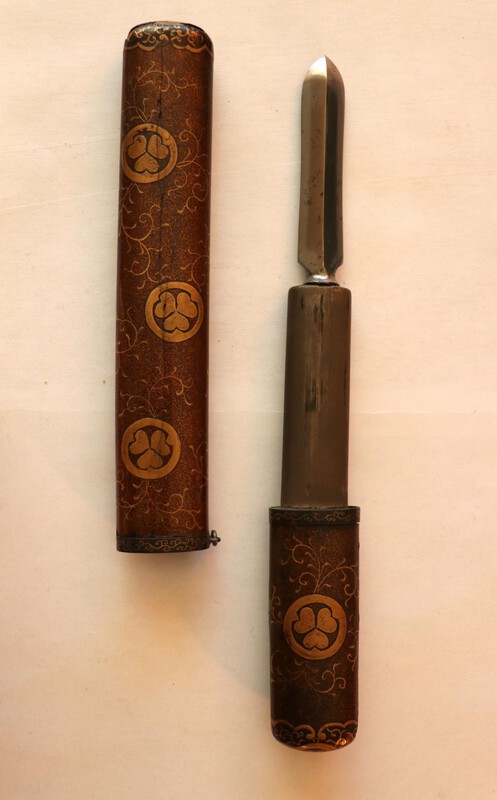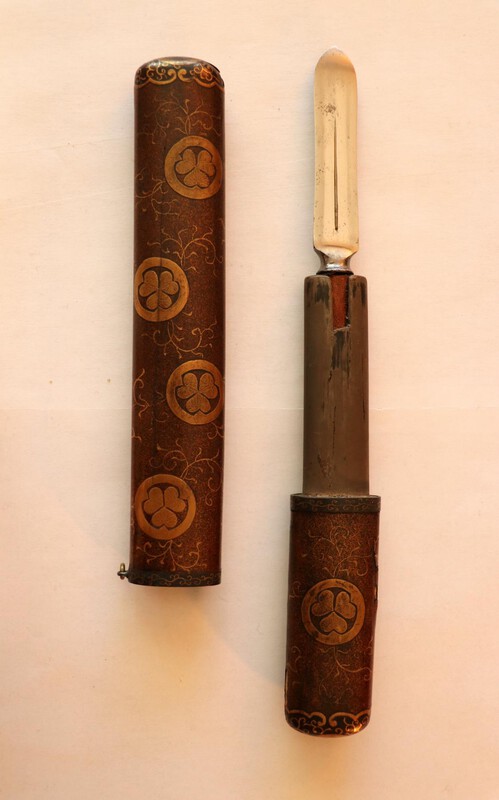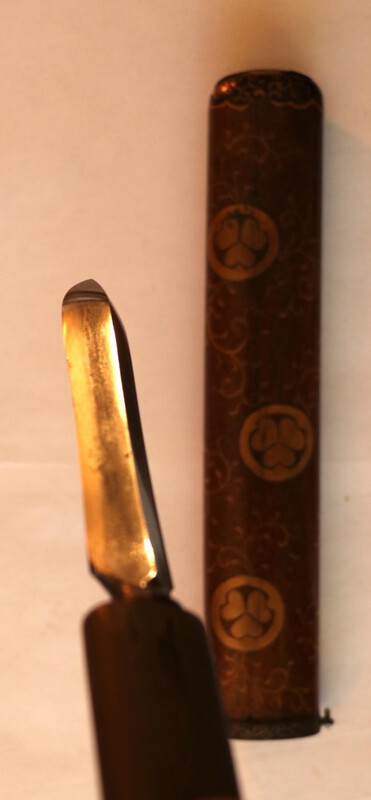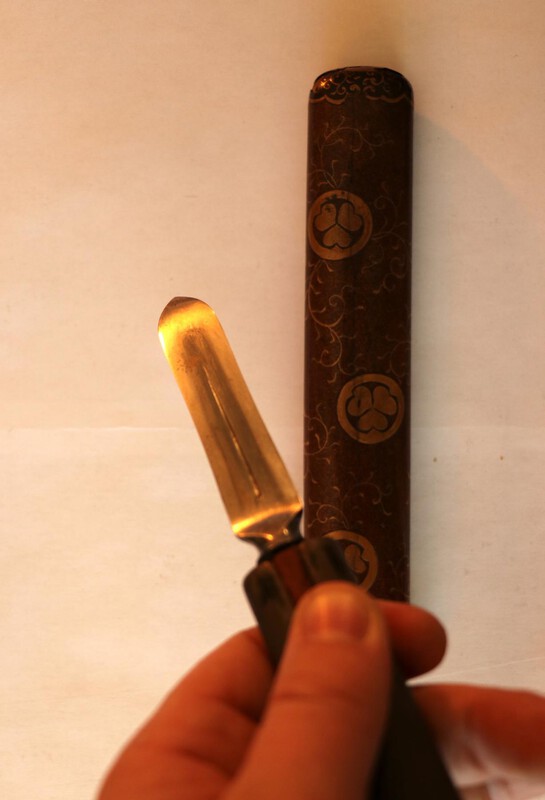Search the Community
Showing results for tags 'restoration'.
-
Recently at the advice of a friend with shared interest in the preservation of nihonto, I’ve tried and now implemented the use of 99% isopropyl alcohol in my sword care regimen. I’ve used it, rather than uchiko or anything so abrasive, to remove old oil at the start of a cleaning or before studying my blades. My test run was on a showato I posses, and with great result I have since implemented it for use with my nihonto. A partially saturated, folded tissue paper wiped gently across a sword does a fantastic and quick job of removing old oil and evaporating. A single follow-up wipe with dry tissue paper or a microfiber cloth ensures dryness and gets up any remaining bits. The blade is left perfectly cleaned, an unharmed. Everything in moderation, of course. Attached is a photo of my gendai Hizen-tō after such treatment. V/R, Jim
- 25 replies
-
- 4
-

-
Hi, I am still new to this forum but i want to share with everyone a unique piece, that is my absolute favorite among our vast collection, from the military history institute museum I work at as restorer/conservator. As the title, possibly somewhat confuzingly states, It is a amalgamation of a Japanese blade and Austrian officer navy fittings. I will post some photos but I just found out that the are not great, i can and will take better photos of the blade around monday next week. I will write everything we know about it plus some history toward the style of fittings it is housed in, and the blade was not removed from the handle yet, I have to get to it and find out if it is signed. I will write some history here: Austrian naval officer were issued navy sabers first in 1827, later in 1837 it was changed to more archaic straight blade "kord" or small sword in english. In 1846 new style of saber was adopted again, this model was based on frech navy saber. This model was used during revolution years of 1848-1849 by officers who joined the rebels. After their surrender loyal navy officers requested new type of saber since previous one was, as a symbol of the emeror, disrespected and loyal officers refuzed to wear it. New model 1850 was created with elaborate carving on the handguard, anchor and mermaids, and later in 1871 hangers were added to the scabbard. for refference i have link to our museum website with example: https://www.vhu.cz/e...rnictva-vzor-185071/ Ownership of thissSaber with katana blade was by previous museum staff attributed to heir to the Heir to the throne of Austro-Hungarian empire Franz Ferdinand d´Este. It would be plausible given the quality of the workmanship on the golden fittings and the blade it self. Heir could have acquired it as a gift from Japan during his travels around the world between years 1892 and 1893. There is also some archival evidence (not sure if we have any photo evidence as well) that he admired the swordsmanship while visiting Japan beign avid and quite skilled swordsman himself, although proficient in saber combat only. Visited some showcases of sword combat and possibly participated in some form of friendly sparring. Unortunately this acquisition story is not supported by evidence and place of discovery. Current research by our curator of arms states that this saber belonged to one Hieronymus (Jeroným) VIII. Colloredo Mannsfeld (1870-1942) There are two pieces of information that suppor that it belonged to him, First: he held rank of Corvette Captain and was for quite some time stationed in Tokyo, later he became naval attaché in Berlin. He was overseeing Mansfeld holdings in Bhoemian lands including castle in town Zbiroh where this very saber was found, which is evidence number two. Either way, now to the saber itself: https://www.vhu.cz/e...ictva-vzor-185071-2/ Speaking about the condition, only damage is to kissaki, some light scratches and wear, possibly due to sheating and unsheating of the blade, othervise it is in great condition. This is the few photos i have so far, I hastily took some because there was not time to fiddle with it, we were close to opening the museum after years of renovations, so I had to put it back on display fast. What I will do next week is to get quality pictures of the blade so that everything can be viewed clearly. I know that Japan had many military swords that bore influence from European sabers of the time that were standart issue up until the return of the katana style of blades before Second World war, but i think this is very unique in that it is standart naval officer saber fittings fitted with nihonto. Photos may not speak to its quality but in person the quiality is amazing. I post this here as a curiosity and subject of research i plan to do with this blade, I plan to take it out of its fittings, probably will be first time since its creation. I hope you like my post here, would be nice if this could spark some good conversation or posibly any ideas of its origin, but I understand that without closeup of the nakago and quality photos of the blade it could prove very difficult. Maybye we can follow up at later date. Anyway thank you for reading this far, In near future I will take this off of the display and do some closeup exmination and share what I found. Cheers
- 16 replies
-
- 17
-

-

-
Maybe someone here on the forum can help me with identifying this Kao mark or the maker on this particular Tsuba that I have recently added to my collection. YES its a little rough and it could do with being restored as the silver has some major wear to it is some places. The Tsuba looks like it was previously mounted at one point or another in its life. more so i am just curious to see what some of the members here say about its origins. The theme is of Uba and one of the Twin Pines but that is just my interpretation of it. Possible Kao Mark could be Kazunori (139 Joly's) but I have my doubts as I cant find any other Kao similar to or matching this one to verify it
-
- 3
-

-
- restoration
- tsuba
-
(and 1 more)
Tagged with:
-
Hi there, Ive got a fairly low quality Wakizashi that until recently had a pretty good shine, I probably should have oiled it, but now all of a sudden one side has gone fairly rusty. The sword is not worth enough to get a proper polish, is there any other way, or a guide to remove this surface rust easily? Any help is appreciated, Thanks
- 3 replies
-
- 1
-

-
- wakizashi
- restoration
-
(and 1 more)
Tagged with:
-
I have these weird circular spots appearing on my blade. they are only visible if the blade is bone dry. when i apply oil, they are invisible. originally i thought those are spots with dried oil, but nothing i did could remove them, now im a bit worried. what could these spots be? they appear in a pretty even pattern
-
I bought this 1944 Gendaito from a friend in Tokyo, and I'm hoping to have a new tsuka refit. I bought this sword for formal tameshigiri, however, the tsuka is loose and cracked in a few places. Additionally, I'm not a fan of its black, lacquered tsukaito or the Gunto Kashira. I was wondering if anyone knew of someone (preferably in the U.S./TX) where I can have a new tsuka fit. Thank you!
- 11 replies
-
- katana
- restoration
-
(and 1 more)
Tagged with:
-
Hello all, I'm back with an update on a wakizashi I acquired a few years ago. I started a thread that can be seen here: to ask about the origins and authenticity of this wakizashi blade. Since then, I have had the blade polished and a shira saya made for it, and i'm basically wondering if any of you more knowledgeable folks on here can offer your opinions on the possible origins of this blade now that more of its features (hamon, hada, boshi, etc) are visible. I was offered a possible explanation for whom the Smith may have been related to, as well as a time era for said Smith, but I'm wondering if the features of the blade align with this info, or if it appears to be from a different time period than previously thought? Thanks a ton for any thoughts you're able to offer 😊 New images of the polished blade can be seen here: https://imgur.com/gallery/N1CslJ3
-
Hi all. New to the forum and to collecting Japanese Swords. A few months ago I bought a Wakishabi which is in a reasonable state of polish but could do with some attention. This weekend I added to my collection a Tanto which was terribly rusty and had been badly scratched with what I assume to have been sandpaper but the guy just wanted to be rid of it as he seemed afraid of it for some reason. I thought the Tanto would be an opportunity to try to learn polishing. I wondered if anyone could read the Mei on either of them.
- 11 replies
-
-
Hello, I recently uploaded a photo of my kozuka blade that I bought from a flea market, but obviously no one could give information with only one photo. So now I’m uploading better photos. There is a writing on the blade which I can’t read as well. My questions are: when was it made? By whom? And should I restore the gold that has worn off from the handle? Thank you.
- 2 replies
-
- 1
-

-
- kozuka
- restoration
-
(and 1 more)
Tagged with:
-
I just wanted to start this new topic about the polishing of my Kanemoto Katana, which has been in the works for over a year. I just received an update from the polisher. The dark spots in the ji and ha have been cleaned, as well as the rust specks on the mune (see before restoration photo below). He is now working with the uchigomori stone for those areas, he will then move on to shiage. At this point I am so far down the "rabbit hole" I will disclose who the professional Japanese sword polisher is. It is Woody Hall who is based out of Las Vegas. Once I get the sword in hand, I will post photos to this topic on NMB. Have a wonderful week everyone.
-
Here is a before and after picture of a Katana sized Ko-Mino Fuchi-gashira (古美濃縁頭) set that underwent professional restorative cleaning. Most of the arduous work was done on the kashira. The set turned out very well in my opinion. The set is hard to photograph in detail because the height difference between the base and the top of the carving is very great. This is a characteristic of the workmanship of the Ko-Mino group. By the Edo Period the difference between the base and the top of the carving was reduced. I am going to upload a full set of high-resolution photographs to my homepage (https://www.tsubaotaku.com/) on the first of March but wanted to show two photographs at lower resolution as a fun preview on NMB. Let me know if you have any questions and feel free to discuss it openly but in a polite and respectful manner. Before: After:
-
Dear NMB fellowship, Once again I hope to draw knowledge from your experience and expertise. In my little quest to get wiser on the subject of Tsuba I have found my self buying different kinds of Tsuba (e.g regarding base materials, design and schools). This time I found a much used brass (Shinchu) Tsuba with the design of the Japanese deity “Daikokuten”, God of fortune and wealth (among a lot of other traits) and a child apparently playing with spinning tops. It shows clear signs of having been mounted (probably on a Wakizashi). Measurement’s: 7,2 x 7,0 x 0,5 cm weight: 130 grams Material: brass with inlay of other soft metals. Mimi is a ring of soft metal that has the feel and look of shakudo (but I am in doubt). There is no iron in or around the Tsuba. Design: Daikokuten with mallet and sack / child playing Mumei School: my own guess would be Mito school? 🧐 Period: probably late Edo period to early Meiji period I would very much appreciate your thoughts on: School and if possible a suggestion on maker Design and carvings Possibility of restoration of patina (looks like a previous owner may have tried to polish the surface with a rather “heavy hand”) All the best Soren Omora side Ura side
-
Bought this the other day thinking it might be cool to restore. The tang looks to have been cut down at some point and has no signature. Scabbard looks like a shin gunto combat cover, but I'm new to this and I could be completely wrong. If it is what tsuba and tsuka would be correct?
-
Hey! This is my first Nihonto I got from eBay for 100$. Was hoping to maybe get any info on it anyone may know like how old the blade is. Also wanted to ask if the crack in the blade would be consider “unrestorable” if I sent it to a professional. Thanks in advanced!
-
What do you do with the leather field scabbard that’s falling apart due to old age ?
-
Hey guys, I've got a wakizashi of a friend here. He is curious about whether or not it makes sense to have restored. I told him it largely depends on the signature. The signature looks confidently written, but that could mean nothing. The blade has a clipped/snapped tip, but it appears to not pass through the hardened edge (a few mm of tip loss). The blade is about 18" (from what I remember, I'll change this once he gets back to me) and appears to have a suguha type hamon. It has a shirasaya with integral wooden habaki in poor condition but appears to have once been of good quality. The blade is quite stout and appears healthy enough to receive a polish. It gave me the impression of a Sukesada-type work. My asks for my friend's blade are: Translation of mei Veracity of mei: shoshin or gimei? Worth restoration or no? General impression/opinion Again, any help/feedback is appreciated guys, Thanks! ~Chris
- 11 replies
-
- wakizashi
- restoration
-
(and 1 more)
Tagged with:
-
Posted across several threads due to size limits....please see my profile for the rest.... As promised I'm sharing an overview of our small collection of nihonto. We're a small volunteer run museum in NZ. We don't know a ton about this collection and due to many factors much of the paperwork is missing, so we don't know the stories around how they came to be in the museum. At some time in the past the blades were all liberally coated in oil, we think maybe linseed oil. We've gently cleaned it off but as you can see it has stained the blades. They are all very much out of polish, which makes it very hard to see the hamon. We've done our best with the photos, to show the elements which would be useful in terms of ID. Full care for all of these nihonto is unfortunately outside the parameters of our current project, both time wise and budget wise. However, if the community on here identifies anything particularly special, we might be able to organise some special treatment. I hope this doesn't sound harsh. It's just that we are cataloguing and caring for an entire museum on a tiny budget. We really love these nihonto which is why we're sharing them here. So, any ID help is greatly appreciated, or just any general info or discussion at all. Every little bit of knowledge helps. Many thanks friends :-) Catalogue number 2379, previously discussed mismatched saya and blade:
- 10 replies
-
Posted across several threads due to size limits....please see my profile for the rest.... As promised I'm sharing an overview of our small collection of nihonto. We're a small volunteer run museum in NZ. We don't know a ton about this collection and due to many factors much of the paperwork is missing, so we don't know the stories around how they came to be in the museum. At some time in the past the blades were all liberally coated in oil, we think maybe linseed oil. We've gently cleaned it off but as you can see it has stained the blades. They are all very much out of polish, which makes it very hard to see the hamon. We've done our best with the photos, to show the elements which would be useful in terms of ID. Full care for all of these nihonto is unfortunately outside the parameters of our current project, both time wise and budget wise. However, if the community on here identifies anything particularly special, we might be able to organise some special treatment. I hope this doesn't sound harsh. It's just that we are cataloguing and caring for an entire museum on a tiny budget. We really love these nihonto which is why we're sharing them here. So, any ID help is greatly appreciated, or just any general info or discussion at all. Every little bit of knowledge helps. Many thanks friends :-)
- 22 replies
-
- 2
-

-
- restoration
- wakizashi
-
(and 1 more)
Tagged with:
-
A Gift to Hachiman・or how NOT to conserve a sword “TSURUGAOKA HACHIMANGU ; Famous temple located at Kamakura, dedicated to the god of war-in 1103 Minamoto Yoriyoshi had erected a temple on Yui-ga-Hama, dedicated to Hachiman, the titular god of his family. Yoritomo transported it (1193) to Kamakura and erected it on the Tsurugaoka hill, where it may be seen to the present day. In 1219 the Shogun Sanetomo went there in great pomp to render thanks for his nomination to the dignity of udaijin. After the ceremony, on descending the steps, his nephew, Kugyo, assassinated him. In 1526 Satomi Yoshihiro, the governor of the province Awa plundered the treasures of the temple but Hojo Ujitsuna obliged him to retreat.- The temple of Tsurugaoka is one of the last remnants of the grandeur of Kamakura. Interesting souvenirs of the middle ages are kept in it.” - E. Papinot The layout of Kamakura today is dominated by Wakamiya Oji, the main street in town, which runs dead straight from the beach to the Tsurugaoka Hachimangu Shrine. It was built by the order of Yoritomo, when the Tsurugaoka Hachiman shrine was erected. Moto Hachiman, or the former Hachiman is not far from my house near Zaimokuza beach. There are three Torii that stand over the road to the shrine from Ni no Torii to Ichi no Torii, which stands at the entrance to the shrine grounds; there is a raised path, which is contained within sloping stone walls like a castle. There are cherry trees set all along this path: the Dankazura. It actually tapers down to about a half its width at the shrine end, but due to an engineered optical illusion, it does not appear so. It seems Yoritomo built everything in the town with an eye to warfare; an invading army might charge down this welcoming path four or five across only to find themselves fighting in space wide enough for only two or three. April is the time to don your kimono and stroll the Dankazura enjoying the cherries in bloom. Yoritomo built the Tsurugaoka Hachimangu in fulfillment of a promise he made at the Moto-Hachiman, “should I be successful in my campaign against the Taira, I will build the biggest Hachiman shrine Japan has ever seen right here in Kamakura”. As we all know, the first Shogun’s prayers were answered, and thereafter many people high and low made offerings in thanks for the favors bestowed upon them by the spirits of this beautiful place. For some four hundred years, the storehouse of the shrine collected treasure until in 1526, during the13th battle of Kamakura,・the aforementioned Satomi Yoshihiro caused the destruction of the temple. What wonderful things were lost, we might never know, but there are as yet interesting souvenirs of the middle ages kept here. Kobizen Masatsune tachi, Kokuho Bizen Nagamitsu tachi, Juyo Bunkazai Kuniyoshi tachi, Juyo Bunkazai Soshu Tsunahiro tachi, Kanagawa ken Juyo Bunkazai Tsunaie tachi, Kanagawa ken Juyo Bunkazai Hirokuni tachi, Kanagawa ken Juyo Bunkazai Kunimura, Senjuin, Chikuzen Nobukuni, and Muramasa, all number among the one hundred or so swords that are still in the storehouse of Hachimangu. Hojo Ujitsuna, the 8th, 9th, and 10th Tokugawa Shoguns and the Meiji Emperor are some of the more notable persons making offerings here. It is the ultimate in presumption to consider myself among their number, but the fact remains that late last year I, too determined to present a sword to the shrine. Last year, I retired my Iai-to and though I felt it didn’t need a polish, I decided to do my bit for the Japanese economy and have it polished and put it in a fresh shirasaya. Unfortunately, as sometimes happens, the kawagane proved too thin and the shingane was exposed during polish, to be expected perhaps with a Kamakura period tachi but the mark of death for a shinshinto blade which mine happened to be. I now had a considerable investment in a sword which had cost me too much already and there was certainly no way for me to recover any of the money spent. I resolved therefore to lovingly preserve it as it had near been a very part of my body daily for close to ten years. In the event of my passing on, on some long distant future day, it could be treasured in my family as an heirloom. Reflecting upon the loose hold my family now has on reality and the sheer lack of interest in things Japanese they exhibit, I began to have my doubts about future generations the more I thought about it. How then to conserve this blade in a way I could be reasonably assured it would not be mistreated in the future. As you must have guessed, I hit upon the brilliant idea of donating the sword to the Hachiman shrine. Owing to the poor condition of the blade, I felt it would surely be rejected by the priests. To my surprise Hon’Ami Koji Sensei, my iai teacher, a sword polisher and conservator of the Hachiman shrine sword collection was delighted with my idea. In fact he sat down and immediately started working on a schedule for the presentation. April, 2001 was determined to be the best time so we set things in motion to carry out our Ho-no-shiki or offertory ceremony. What sword you ask is worth all this. It is not at all special, I assure you. Signed OHIRA TO YUKISADA, Dated MANEN GANNEN HACHIGATSU HI. It is a 2 shaku 5 sun 8 bu katana with chu kissaki, shallow koshizori, tight tight itame hada and a rather wide choji midare hamon. The nakago is 27cm long with kurijiri and kattesagari yasurime with kesho yasuri. The gojimei is located in the shinogiji, midway between the mekugi-ana and the habaki moto. There are 2 mekugi-ana, one of which is a shinobi-ana, which was a popular addition in the Bakumatsu era. Ohira Yukisada or Yukikazu is listed as a Musashi area smith who worked around the time of the Meiji restoration or a little before. He styled himself Yu no shin・or bird of progress・ The To (藤) in the signature is also read Fuji・as in Fujiwara so this is an abbreviation. The year 1860, Manen gannen, started out with the assassination of the great elder II Naosuke, by a group of Mito ronin, angered by his policies of placating the foreign powers and punishing those who opposed him including the lord of Mito. The country was taking sides for a battle many were certain was soon to come, one has to wonder which side of the conflict this blade was destined for. This sword was originally purchased at the Great Western Gun Show, at the San Francisco Cow Palace sometime before 1983 for $700. At that time it was in shirasaya with late Edo/Meiji period copper habaki, iron tsuba, iron fuchikashira, a blue linen wrapped tsuka with white same and menuki which had been stripped by the owner prior to me. I bought it in 1987 in this condition. There is perhaps some justice in this sword finding peace back in Japan after the abuse it suffered in America. I immediately sanded down the shirasaya and painted it with green auto-lacquer. Then began the years of swinging, whacking and cutting. Over time I had a new saya made and rebuilt and rewrapped the handle. Now it has a new silver habaki, shirasaya and proper Japanese polish. On a gorgeous Saturday in April some thirty members of the Kamakura Iaido Kyokai and guests gathered at the Hachimangu Shrine. Dressed in formal montsuki and hakama We collected in the maeden, on the same stage that Shizuka Gozen stood upon as she plead for Yoshitsune’s life in song. We bowed before the priest where receiving his blessing we presented for all the gods and buddhas to see, the faithful sword which had seen me through three thousand days of determined practice. Following this, myself and two others had their new swords blessed in a ceremony known as Nyu-kon-shiki and here upon the stage practiced for the first time with those swords. The swords used in the ceremony to be invested with the true spirit of a samurai sword were tied with mizuhiki cord, after each was blessed an attendant handed the swords to Hon’Ami Sensei who then drew his Umetada Myoju tanto and cut the cord. After which each of us presented five kata or forms to the gods of the shrine. As I took the stage to perform my forms, in each corner sat a friend acting as guard against evil, the Shitenno. In the Northeast sat Iwamura Nobuhiro, who some of you have met, 6th dan Muso Jiki Den Eishin Ryu. To the Southeast from Brazil; Candido Roberto Nunez Sequiera, 3rd dan Toyama Ryu Batto-jutsu. To the Northwest from Sri Lanka, Siri Herath, 2nd dan Toyama Ryu Batto-jutsu and in the Southwest from France, Evelyne Sentenac, Shodan Muso Shinden Ryu. Thus all the parts of the globe were represented as I drew my sword and symbolically cut down evil with my newly christened blade. Following the ceremony there was a luncheon, where I was presented with a certificate acknowledging my gift and where I was asked to give a little speech. I thanked everyone and expressed my hope that the sword would reside within the shrine as a symbol of amity between San Francisco and Kamakura, between the U.S. and Japan and persons everywhere. So now this vet pick-up old beater iaito with Mike Virgadamo saya, Russ Axt handle and wrap, Fred Lohmen menuki, Cary Condell oshigata and lacquer job by yours truly, will join the other swords in the treasure house of the great Tsurugaoka Hachimangu where it will be lovingly cared for, for perhaps another 800 years carrying with it a tale of woe all too many swords know today, along with my sincere thanks for the life changing lessons it taught me during our brief journey together and of course the dear friends it has brought me to. @Kamakura in Japan, Thomas C Helm
- 7 replies
-
- 6
-

-

-
- katana
- restoration
-
(and 1 more)
Tagged with:
-
Hello All! I recently purchased a Japanese sword at auction. After having a jeweler drill out the pin that had been hammered in, I was able to remove the handle (which I think matches Shin-Gunto fittings but I am not sure) and revel that it is signed on both sides of the tang. Unfortunately I don’t have much experience reading the characters so I was wondering if anyone recognized them? I have attached lots of photos but if anyone needs more please let me know. I would love to find out more about the blade and if anyone can tell me if it would be worthwhile to clean/restore the blade it would be much appreciated. also, to be clear I do not intend to use any information provided for selling the below item, I only want to understand more about what I have and the best way to handle it.
- 31 replies
-
- katana
- restoration
-
(and 1 more)
Tagged with:
-
To (only) people who know what they're talking about: I am currently getting fittings together for my katana in shirasaya. I recently purchased a tsuba from the ebay seller Koushuya. This was after almost a year of searching for the tsuba that felt just right. I ended up going with this one, and I am very happy with the purchase. Apparently it's an antique from the Edo period. But I don't really care about that. I just really like how it looks.......makes me feel good. My first question: Should I leave this thing alone and fit it to my katana as is, or should I do something about the rust that looks like it might be eating away at the sukashi? My second question: If I should do something about the rust, what should I do/how should I do it? I don't want to damage/alter this thing (beyond necessarily removing rust) if I can help it. I really like it. Here are some pics:
- 19 replies
-
Hello to all. Long time collector of nihonto but new to teppo. I found this at an antique shop while on vacation in Tennessee. Thanks to some Facebook friends, I know the signature is Goshu Kunitomo Tayosuke Katsumasa. It also contains Niju makibari. Would really enjoy learning more about Tayosuke Katsumasa such as time period he worked, how he is viewed as a smith compared to other Smith's of the time. Any information is greatly appreciated! https://i.imgur.com/caJc0US.jpg https://i.imgur.com/3sjGU9d.jpg https://i.imgur.com/ahkZe9x.jpg https://i.imgur.com/Beft3Bg.jpg https://i.imgur.com/dn4vjjW.jpg
- 18 replies
-
- 1
-

-
- tanegashima
- teppo
-
(and 3 more)
Tagged with:
-
Hi Everyone, I recently got an interesting yari off ebay but it is mounted in a tanto koshirae. It has very impressive lacquer work but the lacquer is cracking, has flaked off in places and it looks like at one point someone used a sharpie to blacken some missing spots that have now grown. I would love to get the yari out and see if it's signed but I am not sure that will ever happen since there does not seem to be a mekugi, it could be glued in, I am not sure. It is so delicate in places I am scared every time I handle it, is there anyone who could correctly get this restored or just stabilized that forum members know of? Maybe this is not the kind of thing that should be messed with at all and just preserved as best it can be as is. On a more general topic, has anyone seen yari mounted like this before? I remember reading somewhere that it was popular in the 1800's to repurpose mounts/mediocre blades to export. I would love opinions as to if this could this weird mounting style be a result of that or could it be a genuine mounting of something earlier? Thanks for your time and ideas. -J.G.





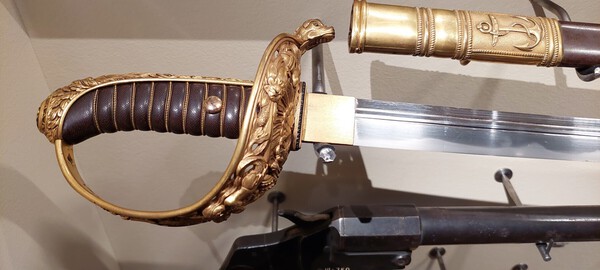


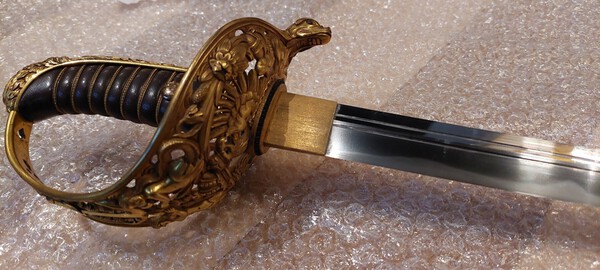









.thumb.jpg.4e89e37cc492793f18c75e4d49f4b453.jpg)
.thumb.jpg.979416a3bbcd93a36c357ae60538492f.jpg)
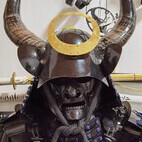

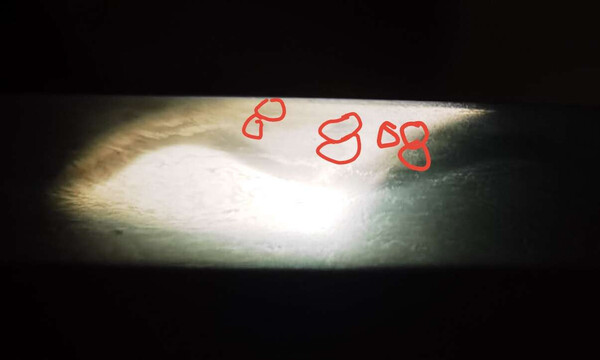

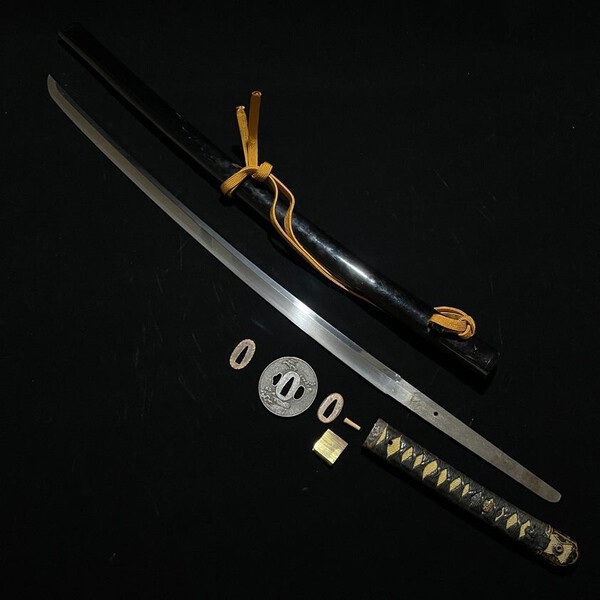

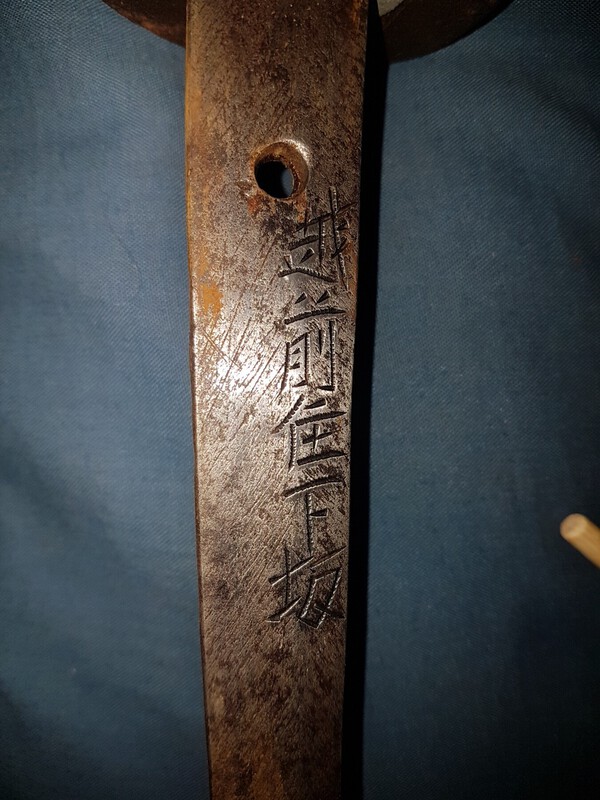




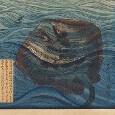




.thumb.jpg.1aa821fb2677d81d007730ce766a475e.jpg)
.thumb.jpg.3d352ef56fa160e6847cd2f06feb05e5.jpg)

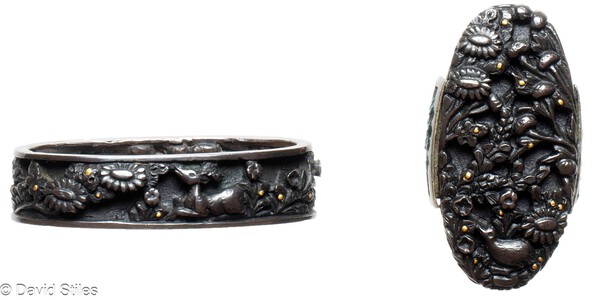

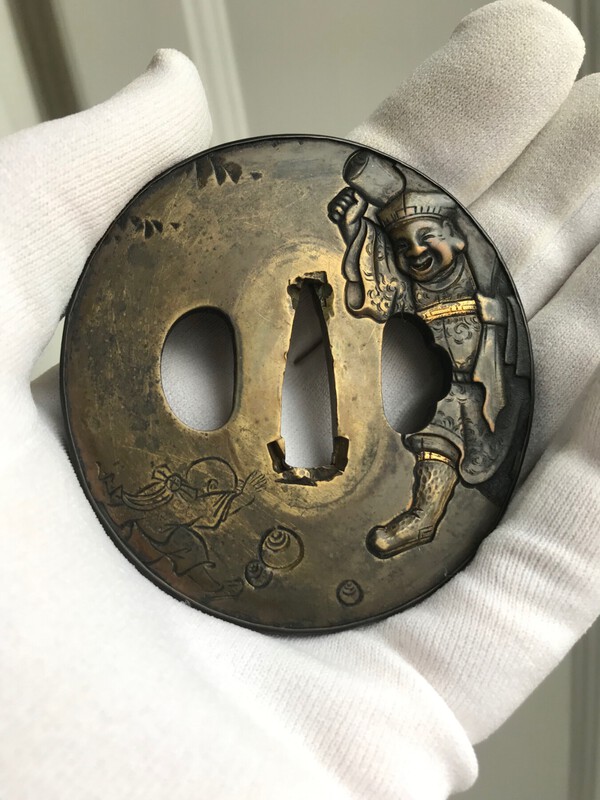
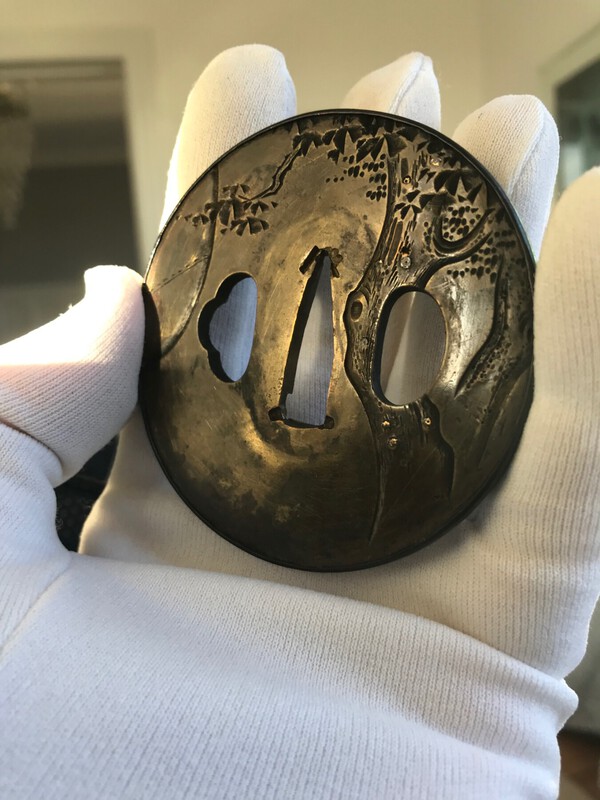
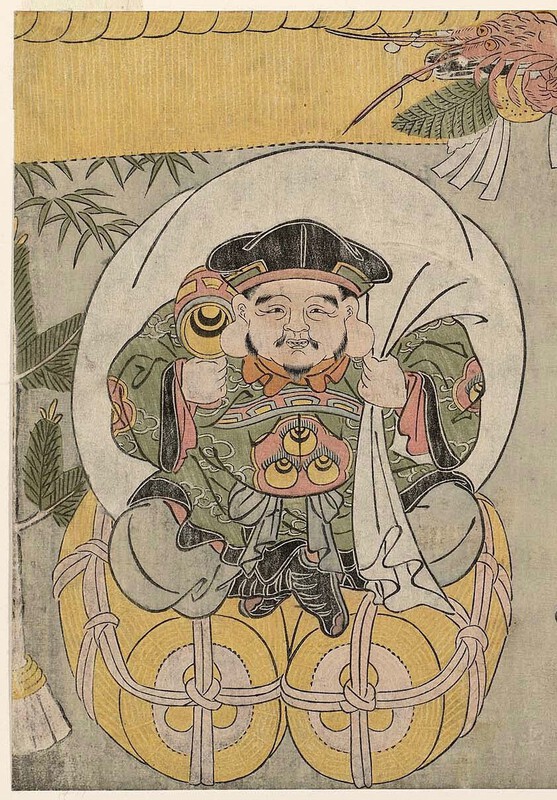
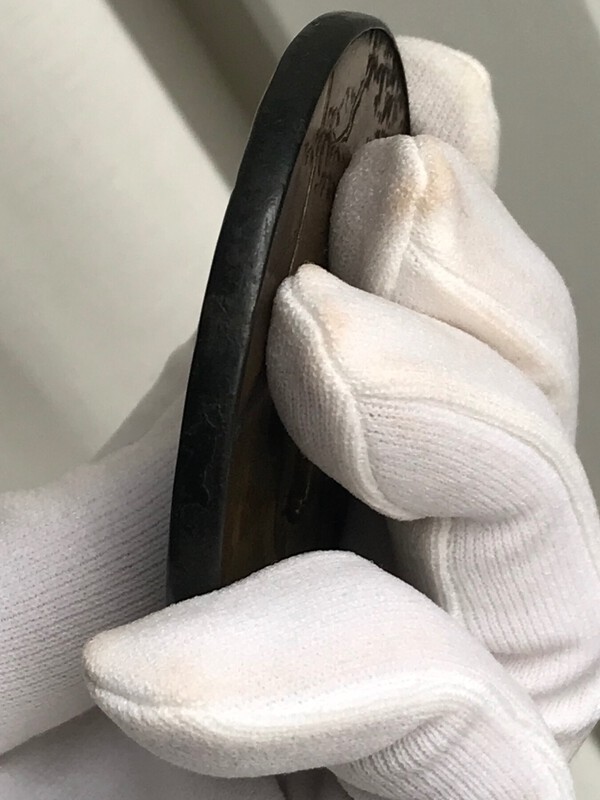
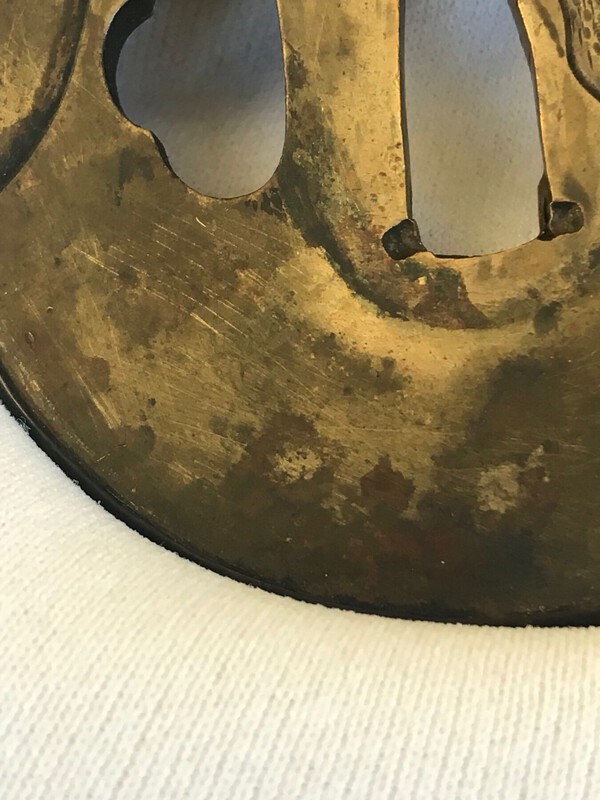



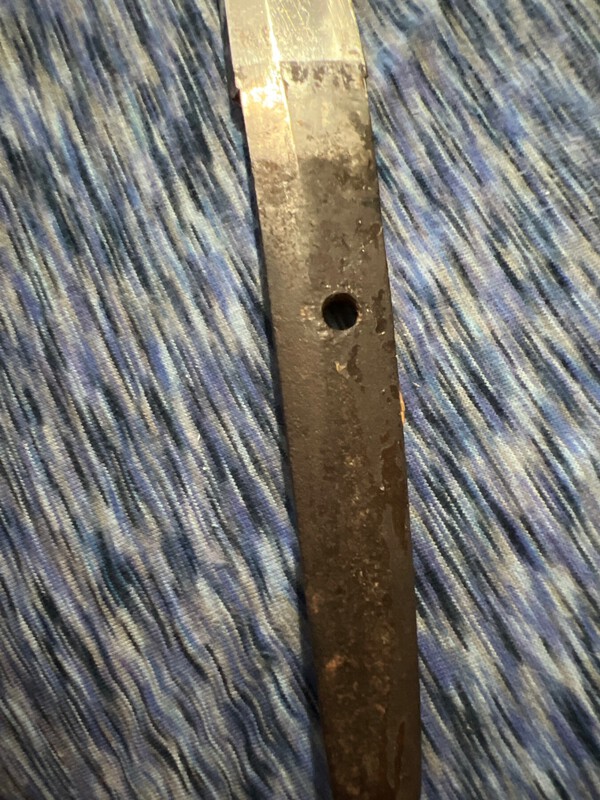



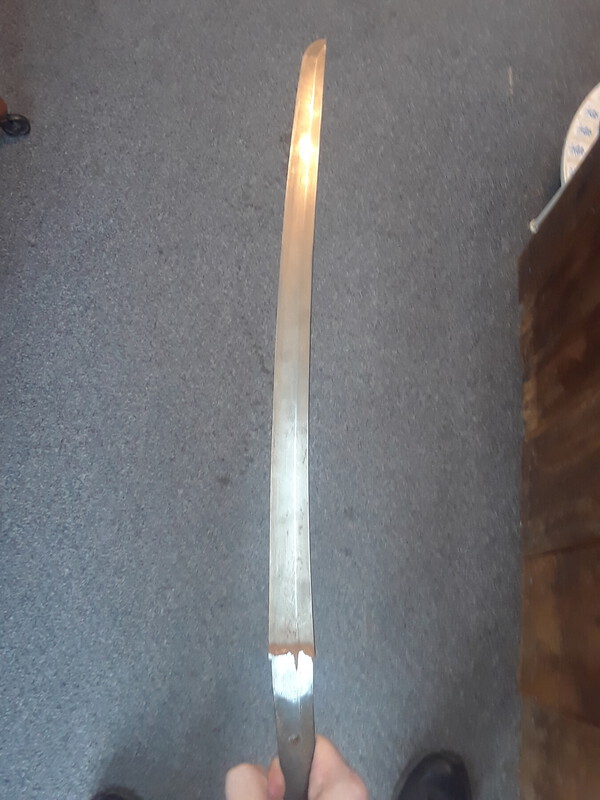


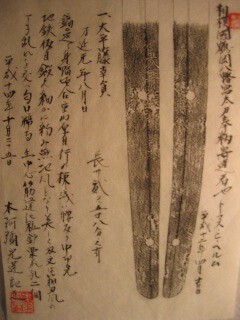

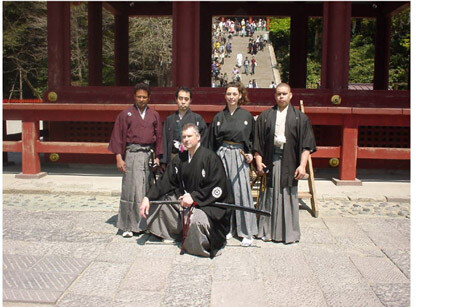


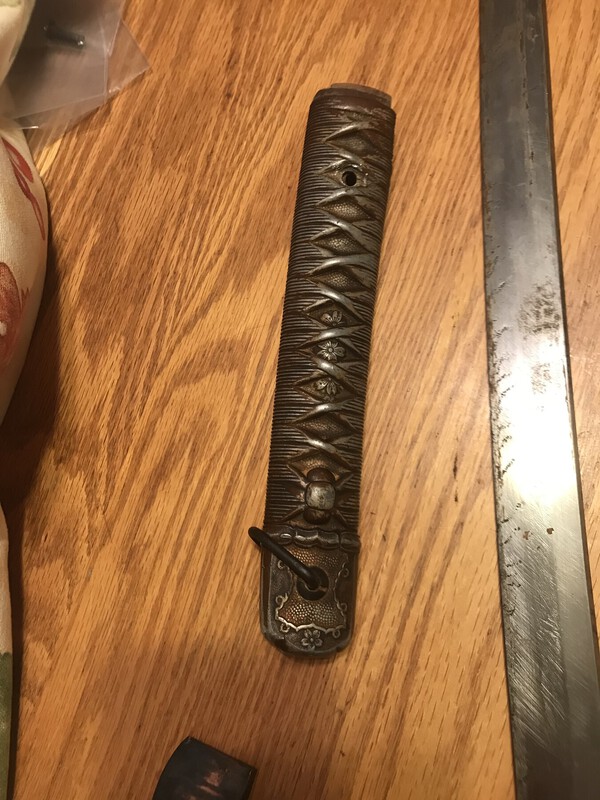









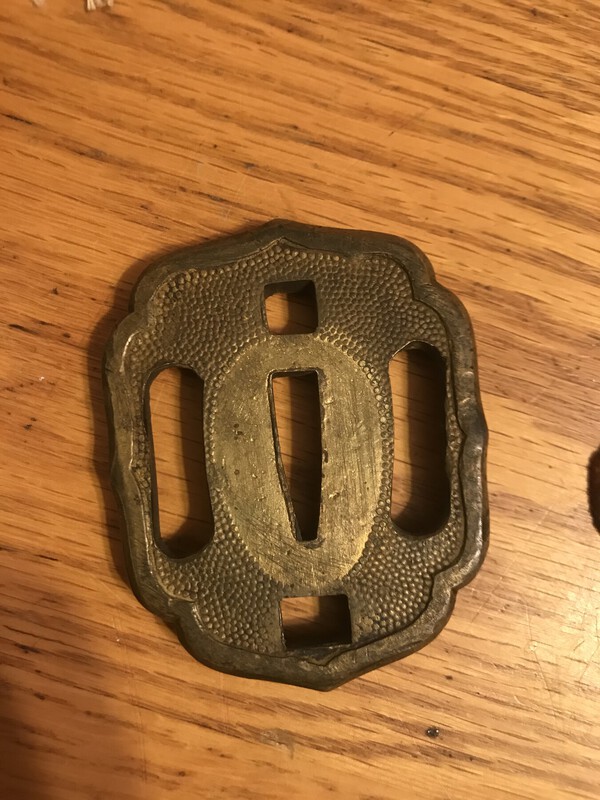






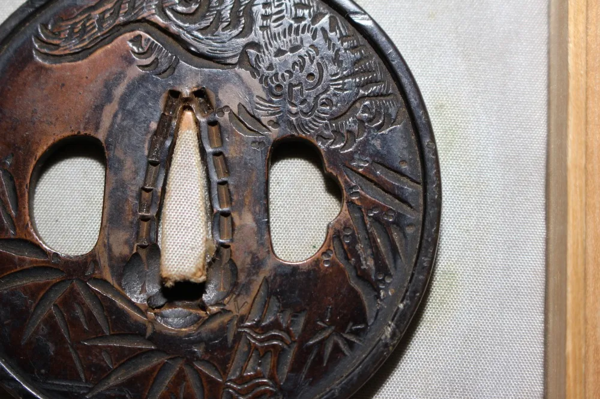

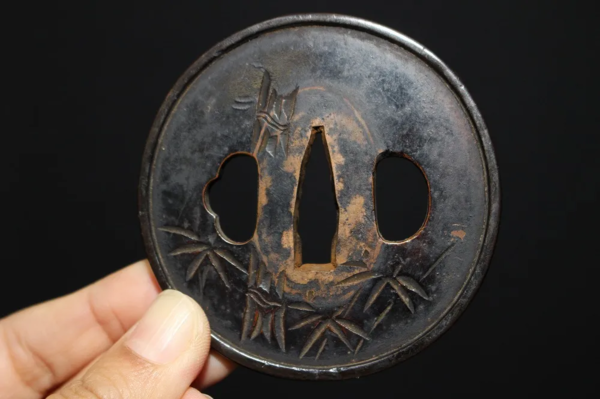
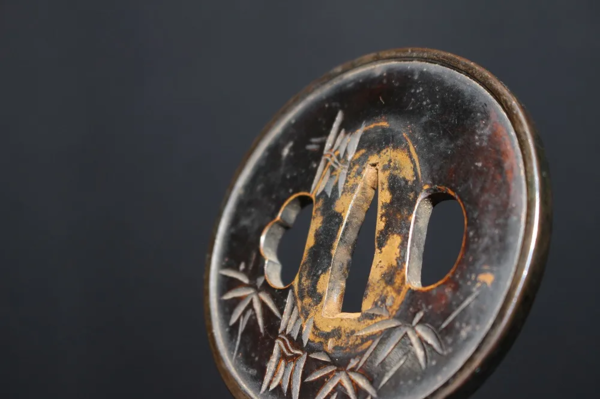


.thumb.jpg.bc10b59027a00aa142dce0349f3ba9e0.jpg)
